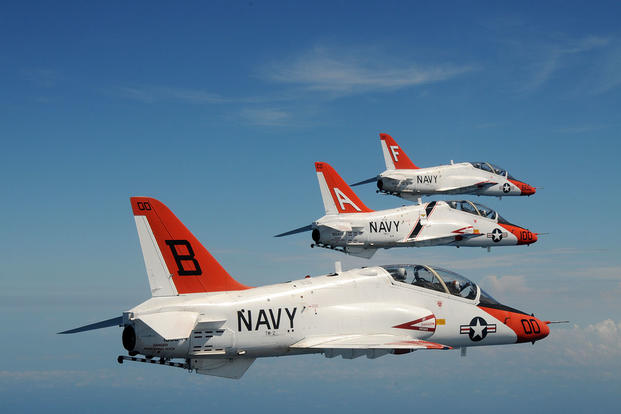By the end of June, the number of student naval aviators to miss their planned end of training and transition to the next squadron will reach 75, the head of Naval Air Systems Command said Tuesday.
Addressing a panel of the Senate Armed Services Committee, Vice Adm. Paul Grosklags said flights on the T-45 Goshawk trainer remain at a standstill, with students delayed in their transition to the fleet at the rate of 25 per month.
Meanwhile, he said, the nebulous problem that caused the Navy to temporarily ground its entire T-45 fleet in the spring continues to puzzle investigators.
"We are not doing well on the diagnosis," Grosklags told Sen. Roger Wicker, chairman of the Senate Armed Services subcommittee on seapower.
As Fox News first reported in April, the Navy implemented an operational pause for its T-45s after 100 instructor pilots refused to fly, citing concerns about the safety of the aircraft after a spike in hypoxia-like cockpit incidents for the aircraft. Ultimately, the Navy would launch a 30-day review of both the T-45 and the F/A-18 Hornet, another platform for which "physiological episodes," as the service calls them, have been reported.
While the service announced in late April that flight operations for the T-45 had resumed with a 5,000-foot altitude limit and a requirement that pilots pull no more than 2 Gs, Grosklags said that, to date, only currency flights for trainers had taken place. Actual training, he testified, remains at a standstill.
"It would be far easier if we could find out what the root cause was, and then go after fixing that root cause," Grosklags said. "To date, we have been unable to find any smoking guns."
He described Navy efforts to address the problem as running on two parallel paths. One effort has involved taking several of the affected aircraft from Naval Air Training Command and bringing them to Naval Air Station Patuxent River, Maryland, where engineers have torn them apart looking for problems with the breathing apparatus. Technicians have inspected every component in the "gas path" of the aircraft, looking for toxins or contaminants, but without success, he said.
"We've subjected each of those individual components to extremes of testing, extremes of environmental conditions, in excess of what we would ever expect to see in the aircraft," Grosklags said. "And we still have not been able to find what we would consider proximate cause of contamination or something being released into the gas path."
Simultaneously, the Navy has zeroed in on "10 to 12" different protective or prophylactic measures for T-45 aircrew that would allow pilots and trainees to identify a potential episode before it becomes a crisis in mid-air. It's this effort that will likely enable student pilots to return to the air, which is expected to happen in a matter of weeks, he said.
"Once ... we've got those individual items all in place for every single aircraft and aircrew down at [Naval Air Training Command, that is the point at which we will consider [resuming training]," Grosklags said.
If the effort is delayed, it could begin to affect air operations in the fleet. Lt. Gen. Jon Davis, deputy commandant of aviation for the Marine Corps, said Tuesday that if T-45 training does not start up again by September, it will cause operational problems for the service's aviation enterprise.
-- Hope Hodge Seck can be reached at hope.seck@military.com. Follow her on Twitter at @HopeSeck.




























